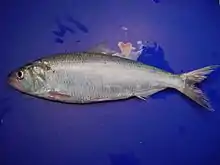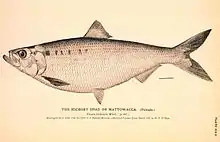Hickory shad
The hickory shad (Alosa mediocris) is a member of the herring family Clupeidae, ranging along the East Coast of the United States from Florida to the Gulf of Maine. It is an anadromous fish species, meaning that it spawns in freshwater portions of rivers, but spends most of its life at sea. It is subject to fishing, both historic and current, but it is often confused with or simply grouped together with catch statistics for American shad (A. sapidissima).
| Alosa mediocris | |
|---|---|
 | |
| Scientific classification | |
| Kingdom: | Animalia |
| Phylum: | Chordata |
| Class: | Actinopterygii |
| Order: | Clupeiformes |
| Family: | Clupeidae |
| Genus: | Alosa |
| Species: | A. mediocris |
| Binomial name | |
| Alosa mediocris (Mitchill, 1814) | |
Distribution, habitat, and life history

Hickory shad range from northern Florida to the Gulf of Maine. The largest populations occur in Chesapeake Bay and coastal North Carolina.[1] It is a schooling anadromous species that inhabits marine waters, probably never far from land. Adults enter estuaries and freshwater tributaries from the St. John's River, Florida, to the Patuxent River, Maryland, to spawn during the spring. Their oceanic movements are poorly documented. [2][3][4]
Spawning occurs from December to June, earliest in Florida and later with increasing latitude.[2][5] The slightly adhesive and demersal eggs, about 1 mm in diameter, appear to be dispersed at random over gravel bars in moderate current. After water hardening, the eggs become semibuoyant and develop as they drift along the bottom.[6][2][7] Fecundity ranges from 43,000 – 475,000 eggs per female, and although the developmental stages of eggs, larvae, and juveniles have been described, little is known concerning the distribution, ecology, and growth rates of these early life stages.[6][2]
Hickory shad live to seven years[8] and both sexes mature at 2–4 years and can repeat spawn. Females are larger than males; in Florida, the average female is 37 cm fork length and the average male is 34 cm fork length.[5]
Hickory shad are piscivorous, feeding primarily on small fishes, although crustaceans and squid contribute to their diet.[3][1] One study showed that their diet on the spawning grounds was almost exclusively fish (97% by weight).[8]
Relationship with humans
Recreational fishery
Hickory shad have a relatively low commercial value, but an increasingly popular recreational fishery exists throughout the mid-Atlantic states. By the late 1980s and early 1990s, hickory shad articles appeared in sport-fishing magazines. Headlines such as “the tough fighting hickory shad swarm near the rock-studded fall line…”[9] and “feast on Rappahannock River hickory shad action” [10] brought attention to the fishery. Subsequently, specialty magazines[11] and sports sections in national newspapers[12] began proclaiming the excitement of hickory shad fishing (“HICKORY SHAD ARE RUNNING!”) and the recovery of the fishery. In the two most recent years of a North Carolina creel survey (2004-2005), hickory shad – a fish only present for two months of the year – moved from sixth- to the fourth-most targeted fish by coastal anglers.[13] They are also taken by recreational fishing for use as bait to catch larger fish.[14]
Literature
Most information about this species is contained in federal and state documents and management plans or theses from universities. Federal publications include reports from the Atlantic States Marine Fisheries Commission's (ASMFC) Interstate Fishery Management Plan for Shad and River Herring.[15][16] Prominent publications by state agencies include reports based on fishery monitoring programs in Connecticut,[17] Pennsylvania and Maryland,[18] North Carolina,[19] South Carolina, Georgia,[20][21][22] and Florida.[23][24][8][25][26] A few publications address coast-wide and/or genus-level stock status and management issues.[27][28] The U.S. Fish and Wildlife Service published a useful series that includes egg, larvae, and juvenile development descriptions of hickory shad.[2] A recent review of hickory shad in Chesapeake Bay places management of this species in an ecosystem context.[29] Three master of science theses also studied them.[30][31][32]
Although hickory shad research has been limited, other clupeids, especially Alosa species in the United States, have received more attention.[33] American shad (A. sapidissima), which overlaps in distribution with hickory shad, has been frequently studied.[34][35][36][37][38][39][40][41][33][42]
References
- Munroe, T.A. (2002) Herrings. Family Clupeidae. In: Bigelow and Schroeder's Fishes of the Gulf of Maine. B. B. Collette and G. Klein-MacPhee (Eds.). Smithsonian Institution Press.
- Hardy, J.D. 1978. Development of fishes of the Mid-Atlantic bight: An atlas of egg, larval and juvenile stages; Acipenseridae through Ictaluridae. U.S. Fish and Wildlife Service. Volume 1:75-88
- Cooper, E.L. 1983. Fishes of Pennsylvania and the Northeastern United States. Penn State University Press, University Park and London. pp. 47–50.
- Rulifson, R.A. 1994. Status of anadromous Alosa along the East Coast of North America. Anadromous Alosa symposium. Tidewater Chapter, American Fisheries Society. pp. 134–158.
- Harris, Julianne E., R. S. McBride, and R. O. Williams. 2007. Life history of hickory shad in the St. Johns River, Florida. Transactions of the American Fisheries Society. 136(6): 1463-1471. DOI: 10.1577/T06-187.1
- Mansueti, R.J. 1962. Eggs, larvae, and young of the hickory shad, Alosa mediocris, with comments on its ecology in the estuary. Chesapeake Science 3: 173-205.
- Cooper, E.L. 1983. Fishes of Pennsylvania and the Northeastern United States. Penn State University Press, University Park and London. pp. 47–50.
- Harris, Julianne E., R. S. McBride, and R. O. Williams. 2007. Life history of hickory shad in the St. Johns River, Florida. Transactions of the American Fisheries Society. 136(6): 1463-1471. DOI: 10.1577/T06-187.1
- Sports Afield. March 1988. Rappahannock shad. 199(3):70.
- Field & Stream. April 1992. Feast on Rappahannock River hickory shad action. 96(12):70A.
- Fly Fisherman. September 2002. Shad restoration continues. 33(6):27.
- The Washington Post. April 3, 1988. Hickory Shad are Running! Sports section, pp. c. 16.; May 11, 2000. Md. Welcomes back the shad; biologists touting victory for rivers’ spawning program. pg. b. 01.
- Murauskas, J.G. and D.G. Mumford. 2006. North Carolina cooperative striped bass creel survey in the central and southern management area (CSMA). Grant F-79, Seg. 2. N.C. Department of Environment and Natural Resources, Division of Marine Fisheries, Morehead City, North Carolina.
- Daniello, Capt. Vincent. "A Guide to Saltwater Live Baits". sportfishingmag.com. Sport Fishing Magazine. Retrieved 21 June 2019.
- ASMFC. 1999. Fisheries Management Report No. 35. Amendment 1 to the Interstate Fishery Management Plan for Shad and River Herring. 1444 Eye St. NW, Washington, DC.
- ASMFC. 2001. Review of the Atlantic States Marine Fisheries Commission Fishery Management Plan for Shad and River Herring (Alosa sp.). 1444 Eye St. NW, Washington, DC.
- Gephard, S. and J. McMenemy. 2004. An overview of the program to restore Atlantic salmon and other diadromous fishes to the Connecticut River with notes on the current status of these species in the river. American Fisheries Society monograph No. 9, pp. 287–317.
- Chesapeake Bay Agreement. 2000. The Renewed Bay Agreement. Retrieved May 26, 2006. http://dnrweb.dnr.state.md.us/bay/res_protect/c2k/index.asp Archived 2004-02-18 at the Wayback Machine[
- NCDMF and NCWRC. 2004. Shad and River Herring Fisheries and Monitoring Programs in North Carolina – 2003: Report to the Atlantic States Marine Fisheries Commission Shad and River Herring Technical Committee. Raleigh, North Carolina.
- Street, M.W. and J.G. Adams. 1969. Aging of hickory shad and blueback herring in Georgia by the scale method. Contribution Series No. 18. Georgia Game and Fish Commission, Marine Fisheries Division.
- Street, M.W. 1969. Fecundity of the hickory shad in the Altamaha River, Georgia. Contribution Series No. 14. Georgia Game and Fish Commission, Marine Fisheries Division.
- Ulrich, G., N. Chipley, J.W. McCord, D. Cupka, J.L. Music, and R.K. Manhood. 1979. Development of fishery management plans for selected anadromous fishes in South Carolina and Georgia. South Carolina Wildlife and Marine Resources Department, Charleston, South Carolina.
- McBride, R.S. 2000. Florida's shad and river herrings (Alosa species): A review of population and fishery characteristics. Florida Marine Research Institute Technical Reports No. 5.
- Harris, J., and R. McBride. 2004. A review of the potential effects of water level fluctuation on diadromous fish populations for MFL determinations. St. John's River Water Management District, Contract No. SG346AA. Florida Fish and Wildlife Conservation Commission.
- McBride, Richard S., and Jay C. Holder (2008). A Review and Updated Assessment of Florida's Anadromous Shads: American Shad and Hickory Shad. North American Journal of Fisheries Management. 28(6): 1668-1686. DOI: 10.1577/M07-066.1
- McBride, Richard S., and Richard E. Matheson. (2011). Florida's diadromous fishes: biology, ecology, conservation, and management. Florida Scientist. 74(3): 187-213.
- Rulifson, R.A. 1994. Status of anadromous Alosa along the East Coast of North America. Anadromous Alosa symposium. Tidewater Chapter, American Fisheries Society. pp. 134–158.
- Yako, L.A., M.E. Mather, and F. Juanes. 2002. Mechanisms for migration of anadromous herring: an ecological basis for effective conservation. Ecological Applications 12(2):521-534.
- Alosine Species Team. (2011). Alosine Species Team Background and Issues Briefs. In: Ecosystem Based Fisheries Management for Chesapeake Bay.(https://web.archive.org/web/20120623223223/http://www.mdsg.umd.edu/images/uploads/siteimages/00-Alosines_Briefs-FINAL.pdf)
- Pate, P.P. 1972. Life history aspects of the hickory shad, Alosa mediocris (Mitchell), in the Neuse River, North Carolina. M.S. Thesis, North Carolina State University. Raleigh, North Carolina.
- Batsavage, C.F. 1997. Life history aspects of the hickory shad (Alosa mediocris) in the Albemarle Sound/Roanoke River Watershed, North Carolina. M.S. Thesis, East Carolina University, Greenville, North Carolina.
- Watkinson, E.R. 2004. Age, growth, and fecundity of hickory shad (Alosa mediocris) in Virginia coastal river. M.S. thesis. Virginia Commonwealth University. Richmond, Virginia.
- Limburg, K.E. and J.R. Waldman, editors. 2003. Biodiversity, status, and conservation of the world's shads. American Fisheries Society Symposium 35. Bethesda, Maryland.
- Atkinson, C.E. 1951. Feeding habits of adult shad (Alosa sapidissima) in fresh water. Ecology 32(3):556-557.
- Dodson, J.J. and L.A. Dohse. 1984. A model of olfactory-mediated conditioning of directional bias in fish migrating in reversing tidal currents based on the homing migration of American shad (Alosa sapidissima). pp. 263–281 in J.D. McCleave, G.P. Arnold, J.J. Dodson, and W.H. Neill, editors. Mechanisms of migration in fishes. Plenum Press, New York.
- Melvin, G.D., M.J. Dadswell, and J.D. Martin. 1986. Fidelity of American shad, Alosa sapidissima (Clupeidae), to its river of previous spawning. Canadian Journal of Fisheries and Aquatic Sciences 43:640-646.
- Quinn, T.P. and D.J. Adams. 1996. Environmental changes affecting the migratory timing of American shad and sockeye salmon. Ecology 77(4):1151-1162
- Leonard, J.B.K., and S.D. McCormick. 1999b. Changes in haematology during upstream migration in American shad. Journal of Fish Biology 54:1218-1230.
- Leonard, J.B.K, and S.D. McCormick. 1999a. Effects of migration distance on whole-body and tissue-specific energy use in American shad (Alosa sapidissima). Canadian Journal of Fisheries and Aquatic Sciences 56(7):1159-71.
- Leonard, J.B.K., J.F. Norieka, B. Kynard, and S.D. McCormick. 1999. Metabolic rates in an anadromous clupeid, the American shad (Alosa sapidissima). Journal of Comparative Physiology and Biology 169:287-295.
- Waters, J.M., J.M. Epifanio, T. Gunter, and B.L. Brown. 2000. Homing behavior facilitates subtle genetic differentiation among river populations of Alosa sapidissima: microsatellites and mtDNA. Journal of Fish Biology 56:622-636.
- McBride, Richard S., and Richard E. Matheson. (2011). Florida's diadromous fishes: biology, ecology, conservation, and management. Florida Scientist. 74(3): 187-213

